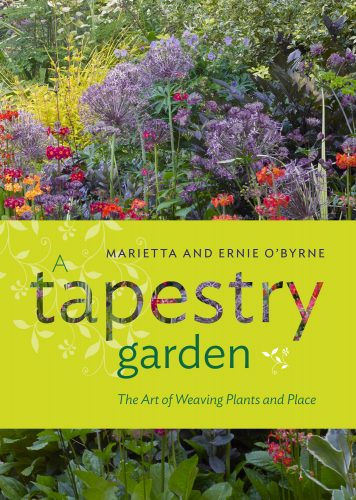
In mid-July I visited Marietta and Ernie O’Byrne, to talk about their recently published book, A Tapestry Garden: The Art of Weaving Plants and Place. Ernie ushered me into the couple’s cool and homey farmhouse kitchen and offered me a glass of homemade juice — three flavors. I chose blackcurrant, my favorite. It was excellent.
It was blazing hot outside, but the garden was resplendent. No plant wilted in the afternoon heat, and the perennial beds, still in midsummer glory, were swimming with the scent of lilies that towered over my head.
Marietta and her first husband bought this 1918 house and 70-acre farm west of Veneta in 1972. A few years later, that husband had departed and Marietta, by then enrolled in a landscaping course at Lane Community College, met Ernie, who would become her second husband.
Ernie sold his own farm and moved in with Marietta. “He had more water,” Marietta said, “but I had a better house!”
Both O’Byrnes dreamed of growing a serious garden there, but making the dream reality didn’t really get under way until they drilled a decent well in the early ’80s. By then they were in the landscape maintenance business, working in other people’s gardens, but that didn’t keep them from laboring long hours together at home, growing plants for clients while building and maintaining their own garden.
Local nurseryman Roger Gossler encouraged them to start a retail nursery, and before long they were phasing out the landscaping business to focus on acquiring and propagating a wonderful inventory of superior and unusual plants from around the world.
Many local gardeners first encountered the O’Byrne garden as customers of Northwest Garden Nursery, a great resource that is sorely missed. The O’Byrnes now focus on breeding world-class hellebores for the wholesale market. Visitors are still welcome, but the nursery is open only a couple of weekends a year for retail sales, offering hellebores in bloom.
It’s no surprise, given how much the authors have to do, that A Tapestry Garden was a few years in the making. It took Marietta a year and a half to write the text, and then Ernie typed it up. Two friends familiar both with the garden and with publishing reviewed the manuscript and made suggestions. Then the authors spent many months reviewing and editing photographs. About half the photos in the book are by the O’Byrnes and half by Doreen Wynja. She took thousands of photos over the course of a year, and sent the O’Byrnes about a thousand for consideration.
High-quality illustrations are essential to this kind of book, and most of those in Tapestry are excellent. Full-page plates capture the overall character of the garden’s different areas, while smaller photos provide details: individual plants, Marietta’s wonderful combinations of color and texture, close-ups of flower, leaf and stem. The endpapers provide a plan of the entire garden, based on the cool aerial photo, taken by Wynja with a drone, which appears on pages 12 and 13.
The preface is an engaging account of the O’Byrnes’ early life stories, revealing the origins of their respective interest in gardening and the natural world. How lucky that these two people, born on different continents, both chose Eugene to settle down, and then found each other!
Following a brief history of the garden’s overall development, we are given a guided tour of the garden in Marietta’s lively prose, with a chapter for each distinct component area — food garden, woodland, rock garden, chaparral and so on — with abundant cultural and descriptive details.
Interspersed through the narrative are sections devoted to intensive treatment of a few favorite plant categories. One section, not surprisingly, describes the origin, goals and accomplishments of the O’Byrnes’ remarkable breeding program with hybrid hellebores.
The O’Byrne garden is quite old by Oregon standards, and contains many choice trees and shrubs that have been lovingly maintained for decades. At just about two and a half acres, it feels bigger — probably because its various habitats accommodate a huge variety of plants, all as happy as they can be because they are well sited. There is little formality. As Marietta puts it, “Harmonious disorder is my comfort zone!”
Collector’s gardens are often incoherent and spotty, but not this one. It’s unified by a consistent vision, conceived with an artistic eye and executed with passion, energy and joy. Gardens are never static and they are, ultimately, ephemeral. A Tapestry Garden goes some way to immortalizing this sweet creation.
Visit northwestgardennursery.com for information about visiting the O’Byrne garden or buying their hellebores. A Tapestry Garden is published by Timber Press.